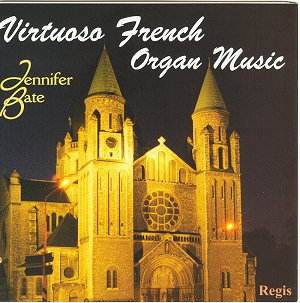The French organ school between the middle of
the 19th century and the end of the 20th
century is amongst the most memorable. During this period many
French organist-composers flourished and influenced each other.
This CD presents the ‘junior contemporaries of Franck’ as the
well-presented booklet informs us. From Saint-Saëns to Langlais
there are close links from one generation to the next. Boellmann
was a pupil of Gigout. Guilmant was a co-student with Widor, another
significant organist-composer, who introduced the later Vierne
to the tradition of the French symphonic organ school. More recently,
Langlais, a co-student with Messiaen, successfully continued the
long French tradition. These composers were influenced by the
organs of Aristide Cavaillé-Coll, built in many significant
churches in Paris. These include Notre-Dame, Saint-Trinité
and Saint Clotilde.
The restored organ by Danion-Gonzalez with a
further 11 new stops has the characteristic rich and ‘round’ sound
of a French romantic organ, blending with the ‘delicate sonorities’
of the past centuries. The big and wonderful acoustics of the
Cathedral ‘enhances the sounds without impairing their color or
clarity throughout the vast building, which contains the highest
nave in Europe’.
The Suite Gothique remains the most famous work
of Boellmann especially the concluding Toccata - brilliant though
not technically difficult.. The Cantilène Pastorale is
dedicated to Guilmant’s father. The March on ‘Lift up your Heads’
uses the same title-theme from Handel’s Messiah. The Improvisation
in A minor is the last piece of the seven improvisations Op.150,
dedicated to Gigout. Vierne’s Impromptu is a scherzo piece that
asks for sort of the fluidity associated with pianistic technique
and blended successfully with the organ colors. Clair de Lune
is dedicated to the American organ-builder Ernest Skinner and
presents a nice vocal melody. The Divertissement is a fluid Allegro
dedicated to Joseph Bonnet, organist and composer and the Carillon
de Longpont is the ‘earliest of several bell pieces by Vierne,
based on the chime of the bells of the chapel at the Chateau of
Longpont’. The pieces contained in Op.31 are marked for ‘organ
or harmonium’ but there is a given organ registration for manuals
and pedal. The Triptyque is dedicated to another significant French
composer, Maurice Duruflé with each of the three pieces
thematically independent. Gigout’s Toccata in B minor can stand
among similar compositions by Widor or Boellmann. The Scherzo,
from the same collection of Ten pieces, is more picturesque. The
Grand Choeur Dialogue is a piece that produces the effect of two
organs in antiphonal conversation.
The recorded sound is well balanced and extremely
detailed in spite of the big acoustics of the cathedral and its
four minute reverberation. As a result Bate offers the listener
a kaleidoscope of warm sounds and color. All the works are performed
with confidence and virtuosic precision. The shaping is well handled
with all necessary breathing and musicality. What is extremely
impressive in this CD is the control of rhythm and tempos giving
the feeling of an orchestra playing. Thus the symphonic character
of some of the pieces comes out perfectly. The sound is fresh
although these recordings date from the early 1980s. It is hugely
enjoyable and highly recommended.
Christina Antoniadou

